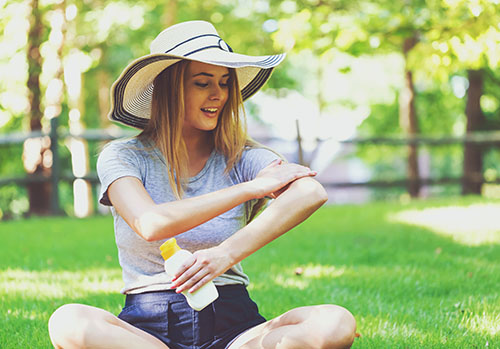
Daily sunscreen use is an important component of not only aging well, but living a long life. Photo provided by Adobe Stock.
Revisiting Sunscreen for Spring
The seasons are starting to turn here in Texas, which means I have about .2 seconds before winter skips spring entirely and goes straight into summer. Before being strong-armed into an early grave by the equatorial blazes of the state, spring is a fleeting, rare, and beautiful spell where it is not just tolerable to be outside, but it’s spectacular. The sun is out, the breeze lively, and the sky cloudless. Everyone in my circle sees this time as a use-it-or-lose-it benefit. We are all constantly outside getting our natural fill before it becomes literally unbearable to exist outdoors.
If you are like me— desperate to warm your scaly, cold-blooded self in the sun after a long winter— now would be an appropriate time to brush up on the SPF standard. I’m a firm believer in daily sunscreen use, but it’s never a bad idea to double down on protective skincare when it comes time to show more of it.
It’s NOT Only Skin Deep
Every single time I go to the dermatologist, the first thing I’m asked is, “do you wear sunscreen?” The doctor conducts themselves and their examination emphatically— like a priest in a confessional— and seems to hinge the entire appointment on my answer. And for good reason, too! Just in case you missed it, sunscreen use has largely become synonymous with skin health over the last decade, and here is why.
According to the Skin Cancer Foundation, “regular daily use of SPF 15 sunscreen can reduce your risk of developing squamous cell carcinoma (SCC) by about 40 percent, and lower your melanoma risk by 50 percent.”
SPF 15! Only SPF 15! That feels low for such a hefty promise, but the math is sound. Not only that, but more and more research is showing that there is no “safe” amount of sun exposure. “Even when it’s cloudy, up to 80% of the sun’s UV radiation (the dangerous stuff) still reaches the earth.” All the more reason to apply and reapply throughout the day.
That AND the projective statistics aren’t in our favor. With trends on the upswing, one in five Americans will develop skin cancer by age seventy, and studies show that if you’ve had five or more sunburns in your lifetime, you’ve already doubled your risk for developing melanoma.
The bell tolls for thee…
Anti-Age Your Skin
If that didn’t sound your internal lifeguard whistle… I don’t understand, but also, I don’t blame you. We live in a world where seemingly everything can give you cancer, and while the sun is a super force unlike anything else we experience on earth and should be treated as such, I get the carcinogen warning fatigue.
Unfortunately for you, my invincible lads and ladies, the risk of death is not the only thing you have to worry about resulting from sun exposure. Living with sun exposure can also be a trial.
If you’re someone who wants to have healthy skin for a long time— skin that looks AND IS young, even, clear, and practically bouncing with a vital network of collagen and elastin— it’s important you buy into this appeal.
CBS wrote a particularly illustrative news story (it went viral) that covered the plight of a sixty-nine-year-old truck driver who had spent nearly three decades on the road. Over his career, the harsh glare of the sun was largely localized to the left side of his body (the sun streamed through his side door window) and drastically altered his appearance over time (click here to see his photo). His face is evenly bisected— the right half appears typical of a man his age, and the left half appears much older, boasting a heavy craquelure of thick, drooping lines and thick ridges. In my opinion, the left side of his face looks more like that of a centenarian than an almost seventy-year-old.
That level of damage indicates a condition known as dermatoheliosis, the breakdown of structures in the skin over a lifetime of unprotected sun exposure. Dermatoheliosis can make skin fragile (causing it to tear easily), and prone to pus-filled infections, lacerations, lifted or burst blood vessels, pigment changes, excessive sagging, thickening, and scarring.
Yes, our skin is meant to lose texture and firmness over time, but unprotected sun exposure can cause it to not only age prematurely, but to atrophy. I don’t know about you, but I’m planning on living well enough now so that the last chapter of life is as comfortable, mobile, and pain-free as possible. That equation does not include the maintenance and discomfort of being stuck in a skin suit that is literally deteriorating on its bony frame.
A Sunscreen Resolution
If you’re already taking to nature and enjoying the bloom of spring, do yourself a favor and start making sunscreen use a habit. It doesn’t take long to apply an effective coat. If you are using the right kind, you should not even be able to feel it when it is on your skin. It IS an extra step before the fun, but if it will keep your skin cancer-free, healthy, painless, and low-maintenance for the rest of your life, it is worth spending a few minutes on each day.
If you are interested to learn more about what kinds of sunscreens you should be using (or more importantly, should NOT be using), you’re welcome to peruse this article.
Got Medicare Questions?
We hope that this information on sunscreen and sun safety has been interesting to you!
There are lots of things out there that are more interesting than Medicare– let us help you answer your questions so that you can get back to the activities that you enjoy the most.
Call (888) 446-9157, click here to get an INSTANT QUOTE, or leave a comment below!
See our other websites:

